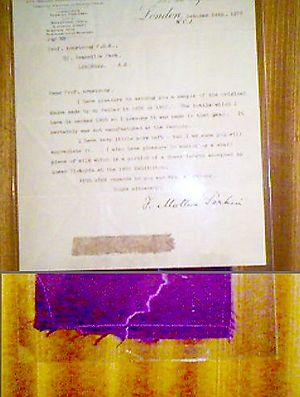Mauveine facts for kids
Mauveine was also known as aniline purple and Perkin's mauve. It was the first synthetic organic chemical dye, discovered by accident in 1856.
History

In 1856, William Henry Perkin, then 18, was given a challenge by his professor to synthesize quinine. His professor, August Wilhelm von Hofmann, was the first director of the Royal College of Chemistry in London.
In one attempt, Perkin oxidized aniline using potassium dichromate. This failed, but cleaning the flask with alcohol, Perkin noticed the alcohol had turned purple.
The dye turned out to be suitable for silk and other textiles. It was patented by Perkin, who the next year opened a dyeworks mass-producing it at Greenford on the banks of the Grand Union Canal in London.
It was originally called aniline purple or Tyrian purple, the name of an ancient natural dye got from a mollusc. In 1859, the colour got the name mauve in England from the French name for the mallow flower, and chemists later called it mauveine. By 1870, the huge demand dropped when other colours were launched in the synthetic dye industry. Mauvine was the first of many.
The structure of mauveine was not fully identified until 1994.
See also
 In Spanish: Mauveína para niños
In Spanish: Mauveína para niños


